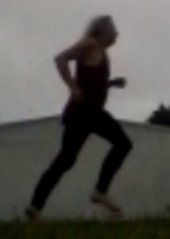Travis Johnson wrote:Not to change the topic any, but sometimes a person just cannot change their gait.
I have been consciously and methodically working on changing my gait for two years. It's been a slow (and painful) process fraught with injury and setback. and also filled with healing. I still have a long way to go before I will feel like I have a "consistently proper" gait.
When I originally started walking and running barefoot, two of my toes would drag on the ground, causing the skin to wear off those toes until they bled. That was an ongoing chronic condition. I coped by either just bleeding, or by putting tape over the spot that was getting rubbed raw. The toes had very limited mobility, and the end joint seemed seized up. After being out of shoes for about 6 months, the tendons had stretched enough that the toes weren't rubbing on the ground, and the bleeding stopped. After about 1.7 years, the end joints in those toes acquired a very slight amount of mobility. The toes spent 50 years getting into that condition, I can be patient as they work through regaining mobility. All manner of other joints in my feet and ankles, started becoming (more) mobile after being essentially immobile for most of my life. That created a lot of pain, over an extended time, as one joint or another gained mobility, then started aching due to the atrophied muscles and ligaments being strengthened.
One huge benefit of living habitually barefoot, is that my knees, hips, back, and neck also realigned, and chronic pain in those joints and muscles disappeared. My calf-muscles and Achilles tendon seem like they are finally getting to the point where a consistently proper gait seems possible. They have been the area most prone to overuse injury. I am going to need to change my wardrobe, because my calf-muscles are becoming too big to fit comfortably into the styles of blue-jeans that I have worn my whole life.
So back to the callus issue... I have noticed when working on the farm with hand tools, that calluses tend to form when a shearing/friction motion is present. For example by twisting a tool in my hands. They don't form much at all, if the force applied to the tool is exactly perpendicular to the hands. I only have one callus left on my feet. That is on the outside of my big toe, over the spot where there was a lot of friction for many decades. Places where my feet currently meet the ground are not forming calluses, because the force applied is perpendicular to the ground, and I am not twisting my feet on the ground. So when I wonder about gait, I am wondering if some sort of twisting/scuffing motion is occurring while moving. I notice when I walk or run barefoot, that my stride length is much shorter than while walking shod. I wonder if long-stride length might be contributing to the recurring callus?
Jason: I wonder where the callus is located that is causing you trouble?






 1
1




 1
1




 1
1









 2
2




 6
6








 1
1









 1
1





 1
1




 1
1













 1
1








 1
1








